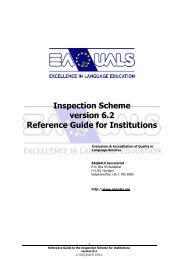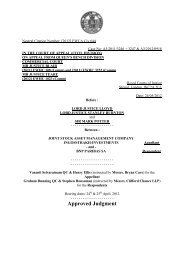Good practice contract management framework - Support
Good practice contract management framework - Support
Good practice contract management framework - Support
Create successful ePaper yourself
Turn your PDF publications into a flip-book with our unique Google optimized e-Paper software.
18 Section Two <strong>Good</strong> <strong>practice</strong> <strong>contract</strong> <strong>management</strong> <strong>framework</strong><br />
Managing <strong>contract</strong> risks<br />
(a) Identifying <strong>contract</strong> risks<br />
2.5 The initial stage in any risk <strong>management</strong> process is to identify the key risks. In the<br />
case of service <strong>contract</strong>s, the key risks can be categorised into three broad areas.<br />
<br />
Service failure – the most obvious and common risk is that the supplier does<br />
not deliver the service to the standard or timeliness specified in the <strong>contract</strong>.<br />
Service failure can range from a relatively minor shortfall against required service<br />
levels to complete failure. Minor failure could be driven by, for example, the<br />
customer providing unclear specifications, a lack of supplier capability, or a supplier<br />
cutting corners to improve profitability. At the extreme, financial or other problems<br />
could cause the supplier to go out of business, unilaterally withdraw from the<br />
<strong>contract</strong>, or be unable to deliver the service.<br />
<br />
Reputational damage – even if the service is provided as specified in the<br />
<strong>contract</strong>, there is a further risk that the supplier in some manner causes harm to<br />
the customer organisation’s reputation. For example, the supplier may act illegally<br />
or in a manner that conflicts with government policy. Supplier problems could result<br />
in sensitive or personal information not being kept secure, or a supplier may be<br />
dealing with vulnerable citizens where poor performance would have operational<br />
implications and cause reputational damage to the customer organisation.<br />
<br />
Additional cost – this category of risk covers cases where the <strong>contract</strong> costs<br />
more than expected or budgeted, and those costs do not represent value for<br />
money. The amounts paid to the supplier may increase as a result of changes<br />
in the quantity or quality of the services delivered or their prices. For example,<br />
user demand may be higher than expected. In such cases, additional costs<br />
may be reasonable and offer value for money. But it is vital that processes are<br />
well managed so that value for money is tested and achieved on this additional<br />
expenditure. The internal costs of the customer organisation may also increase.<br />
For example, poor user perception of the service could lead to more work being<br />
done internally by the customer’s staff rather than by the supplier, with consequent<br />
additional costs.<br />
(b) Quantifying <strong>contract</strong> risks<br />
2.6 Once the core risks associated with a <strong>contract</strong> have been identified, the scale<br />
or importance of each risk needs to be quantified. This can be done by assessing<br />
two elements.<br />
<br />
The likelihood (probability) of the risk materialising.<br />
<br />
The impact if the risk does materialise.





![[2012] UKUT 399 (TCC)](https://img.yumpu.com/51352289/1/184x260/2012-ukut-399-tcc.jpg?quality=85)





![Neutral Citation Number: [2009] EWHC 3198 (Ch) Case No: CH ...](https://img.yumpu.com/50120201/1/184x260/neutral-citation-number-2009-ewhc-3198-ch-case-no-ch-.jpg?quality=85)





